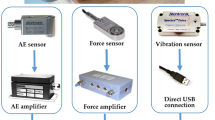Abstract
In order to realize an intelligent CNC machine, this research proposed the in-process tool wear monitoring system regardless of the chip formation in CNC turning by utilizing the wavelet transform. The in-process prediction model of tool wear is developed during the CNC turning process. The relations of the cutting speed, the feed rate, the depth of cut, the decomposed cutting forces, and the tool wear are investigated. The Daubechies wavelet transform is used to differentiate the tool wear signals from the noise and broken chip signals. The decomposed cutting force ratio is utilized to eliminate the effects of cutting conditions by taking ratio of the average variances of the decomposed feed force to that of decomposed main force on the fifth level of wavelet transform. The tool wear prediction model consists of the decomposed cutting force ratio, the cutting speed, the depth of cut, and the feed rate, which is developed based on the exponential function. The new cutting tests are performed to ensure the reliability of the tool wear prediction model. The experimental results showed that as the cutting speed, the feed rate, and the depth of cut increase, the main cutting force also increases which affects in the escalating amount of tool wear. It has been proved that the proposed system can be used to separate the chip formation signals and predict the tool wear by utilizing wavelet transform even though the cutting conditions are changed.
Similar content being viewed by others
References
Tangjitsitcharoen S (2011) Advance in detection system to improve the stability and capability of CNC turning process. J Intell Manuf 22:843–852
Andreasen JL, Chiffre LD (1993) Automatic chip breaking detection in turning by frequency analysis of cutting force. Ann CIRP 42(1):45–48
Tangjitsitcharoen S (2009) In-process monitoring and prediction of chip formation and chatter for CNC turning. J Mater Process Tech 209:4682–4688
Moriwaki T, Shibasaka T, Tangjitsitcharoen S (2004) Development of in-process tool wear monitoring system for CNC turning. Int J Jpn Soc Mech Eng 47(3):933–938
Doja B, Singh DK (2012) Analysis and effect of input parameters on surface roughness and tool flank wear in turning operation. Int J Eng Sci Technol 4:2759–2765
Ganchev T, Siafarikas M, Mporas I, Stoyanova T (2014) Wavelet basis selection for enhanced speech parametrization in speaker verification. Int J Speech Technol 17:27–36
Kwak JS (2006) Application of wavelet transform technique to detect tool failure in turning operations. Int J Adv Manuf Tech 28:1078–1083
Tangjitsitcharoen S, Saksri T, Ratanakuakangwan S (2015) Advance in chatter detection in ball end milling process by utilizing wavelet transform. J Intell Manuf 26:485–499
Lee LC, Lee KS, Gan CS (1989) On the correlation between dynamic cutting force and tool wear. Int J Mach Tool Manu 29(3):295–303
Tangjitsitcharoen S, Thesniyom P, Ratanakuakangwan S (2015) A wavelet approach to predict surface roughness in ball-end milling. Proc Inst Mech Eng B J Eng Manuf:1–11. https://doi.org/10.1177/0954405415605951
Sassantiwong M, Tangjitsitcharoen S (2015) In-process prediction of straightness in CNC turning by using wavelet transform. 2nd International Conference on Green Materials and Environmental Engineering 199–203
Tangjitsitcharoen S, Samanmit K (2015) Monitoring of chip breaking and surface roughness in computer numerical control turning by utilizing wavelet transform of dynamic cutting forces. Proc Inst Mech Eng B J Eng Manuf:1–16. https://doi.org/10.1177/0954405415601804
Tangjitsitcharoen S (2010) In-process prediction of surface roughness by utilizing the cutting force ratio. Trans NAMRI/SME 38:307–315
Badru D, Singh DK (2012) Analysis and effect of input parameters on surface roughness and tool flank wear in turning operation. Int J Eng Sci Technol 4(6):2759–2765
Choudhury SK, Kishore KK (2000) Tool wear measurement in turning using force ratio. Int J Mach Tool Manu 40:899–909
Oraby SE, Hayhurst DR (1995) Development of models for tool wear force relationships in metal cutting. Int J Mech Sci 33(2):125–138
Tangjitsitcharoen S, Wongtangthinthan C (2016) Advanced in tool wear prediction in CNC turning by utilizing average variances of dynamic cutting forces. Full Paper Proceeding ECBA-2016, 380(11):1–8
Tangjitsitcharoen S (2011) Advanced monitoring of tool wear and cutting states in CNC turning process by utilizing sensor fusion. Adv Mater Res 189-193:377–384
Funding
This work was supported by the International School of Engineering (ISE), Chulalongkorn University, Bangkok, Thailand, 2014–2015.
Author information
Authors and Affiliations
Corresponding author
Rights and permissions
About this article
Cite this article
Tangjitsitcharoen, S., Lohasiriwat, H. Intelligent monitoring and prediction of tool wear in CNC turning by utilizing wavelet transform. Int J Adv Manuf Technol 99, 2219–2230 (2018). https://doi.org/10.1007/s00170-017-1424-5
Received:
Accepted:
Published:
Issue Date:
DOI: https://doi.org/10.1007/s00170-017-1424-5




